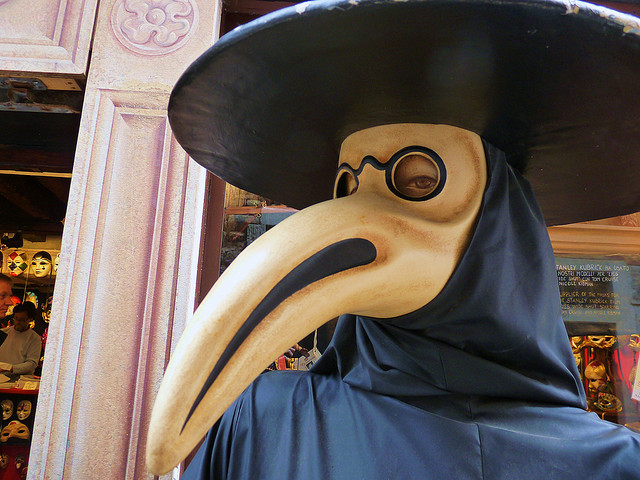
One of the scariest costumes of all time seems to be staging a comeback: the plague doctor. Plague doctors tended to victims of the Bubonic Plague, the abominable disease spread by fleas on rodents that killed roughly half of Europe during the 14th century and erupted again across parts of Europe during the 17th century.
To protect themselves against the disease doctors wore ankle length overcoats, wide brim hats, boots, gloves and a mask with a long curved bird-like beak that was filled with sweet strong-smelling substances like dried roses and carnations, or lavender. Herbs like mint or spices like camphor could also be put in the base of the beak. The intention of the mask was to keep away “evil” smells, which were thought to be the principal cause of plague. On the contrary, good smells, it was thought, were capable of keeping the evil ones at bay. The leading disease theory of the day was the miasma theory, which said that diseases such as plague and cholera were caused by noxious air emanating from rotting organic matter.
The plague doctor outfit also included a wooden cane. Doctors used the cane to point out specific regions on victim’s bodies that needed attention without having to touch them, which of course would put the doctors at risk of contracting plague themselves. Doctors also used plague canes to remove clothing from victims, to check a victim’s pulse and sometimes simply to keep infected people away. The nefarious looking mask of the plague doctor is an invention attributed to Charles de Lorme, a 17th century French medical doctor whose patient list included such royal personages as the Medici Family, the Duke of Orléans and three French kings: Henry the IV, Louis the XIII and Louis the XIV.
Searching for plague masks now on the internet will probably lead you to the Etsy shop of Tom and Jill Banwell, who among other things craft “steampunk plague doctor masks”, which sell for anywhere from $89 to $475. Much less expensive plague doctor masks—more for hanging on the wall as art than wearing on the face—can be found in the Etsy shop, MischiefInTheMaking. On a site called helpforteachers.com, viewers are instructed in how to make their own plague doctor mask with pieces of construction paper, the inner cardboard from a toilet paper roll, scissors, a stapler and masking tape.
Other Great Reads: The man behind the world’s most famous mask
Plague mask creator Charles de Lorme was born in 1584 and graduated from the University of Montpellier in 1607 before coming to Paris to practice medicine under his father. He was an open-minded and intelligent man and while in Paris published a series of papers on some of the most important topics of the day. The following are titles of some of De Lorme’s papers:
“Should one use the same remedies for lovers as are used for the insane?”
“Is the althaea officinalis [marshmellow root] a living being, and does it have the properties which Pedanius Dioscorides and Galen ascribe to it?”
“Are the lives of kings, princes and great men less exposed to disease and longer than common people and peasants?”
“Are blister-causing agents good for arthritis pain?”
“Can one prepare a poison that kills at a certain time?”
“Is it permissible, when a pregnant woman suffers from an acute illness, to prescribe her an abortion?”
Later De Lorme became known as an advocate of antimony, a lustrous gray metal thought to be a health-preserving potion. He administered antimony to numerous kings and princes. But of course his much more lasting contribution has remained the plague mask.
The only thing better than the plague doctor costume, this seventeenth century plague doctor costume poem:
As may be seen on picture here,
In Rome the doctors do appear,
When to their patients they are called,
In places by the plague appalled,
Their hats and cloaks, of fashion new,
Are made of oilcloth, dark of hue,
Their caps with glasses are designed,
Their bills with antidotes all lined,
That foulsome air may do no harm,
Nor cause the doctor man alarm,
The staff in hand must serve to show
Their noble trade where’er they go.










Dave
Another “surviving” poem-writing of the plague years – which I sometimes played with my sister when under 10.
Ring around the rosie –
A pocketful of posie –
A tissue A tissue
We all fall down –
Rosie – refers to the plagues buboes
Posie – a sachet of herbs and spices ( a beakful in the mask’s case )
A tissue – wheezing ( lungs full of fluid )
Fall Down – Die
As a 10 year old we were not aware of the history – it was just a circle game